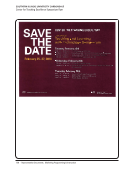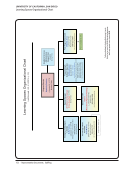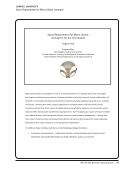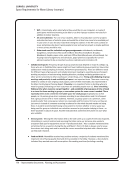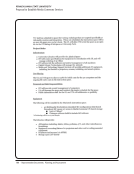SPEC Kit 342: Next-Gen Learning Spaces · 81
The Undergraduate Library will be renovated, repurposed, and transformed into a Learning Commons with two floors
devoted to learning spaces.
There is interest in building an experimental teaching lab/space where professors and librarians (and other campus units
such as Online and Distance Learning, Center for Teaching Excellence) can try new pedagogical techniques related to
hybrid and flipped teaching.
Transforming 30,000 square feet of space on the second floor into a modern group/ collaborative environment.
Undertaking a master space plan for the libraries, which will ultimately result in changes to some if not many of our
learning spaces.
We are on the cusp of hiring a new department head for teaching &learning. The expectation is that we’ll be
interacting more with faculty and programs in the development and assessment of how library resources can be better
incorporated. With this programmatic shift will come a new way of building and using learning spaces.
We are planning on renovating the Main Library Exhibit Hall.
We are renovating the learning space area of the mathematics/computer science library. We will create an active
multifunction learning classroom. The furniture and the large flat screens will be mobile so the space can be configured
for several types of uses (collaborative work, individual work, classrooms).
We are working with architects to reconfigure 18,000 square feet in one library into an open environment that
encourages collaborative work and instruction among students, faculty, academic technologists, and library staff.
We have two new librarians who will be expanding our teaching and learning: an undergraduate experience librarian
and an instructional design librarian. We are also just starting a master space plan for the Libraries that will help
determine the direction for all of our spaces.
We plan to bring more interactive, flexible programming and exhibit spaces to our main level.
We plan to explore more teaching spaces that support new models of teaching such as the “flipped classroom.”
Will add a café and refurbish a large area dedicated to undergraduate collaborative/social learning considering need for
graduate study commons and/or faculty commons.
Within the past few years, some space on the first floor has been repurposed from shelving for current print journals
to group study space, and it will be remodeled soon to add modular furniture. The print journal shelving has been
condensed to make more space to accommodate seating for students.
29. Please briefly describe what you envision as the role of next-gen learning spaces in the future of
research libraries. N=47
A space that can accommodate multiple learning/research activities and styles, and which invites students to devise
their own approaches to assignments.
Access to hardware, software, and content that allows students and scholars to study new modes and forms of human
creativity and knowledge, as well as providing the tools and resources for students and scholars to create knowledge in
a variety of formats, both traditional and new.
Align closely with strategic needs of institution, support curricular change (be modifiable, flexible), responsive to
changing needs of students. Fine Arts: Next-gen learning spaces are the future of the research library. In the Arts
The Undergraduate Library will be renovated, repurposed, and transformed into a Learning Commons with two floors
devoted to learning spaces.
There is interest in building an experimental teaching lab/space where professors and librarians (and other campus units
such as Online and Distance Learning, Center for Teaching Excellence) can try new pedagogical techniques related to
hybrid and flipped teaching.
Transforming 30,000 square feet of space on the second floor into a modern group/ collaborative environment.
Undertaking a master space plan for the libraries, which will ultimately result in changes to some if not many of our
learning spaces.
We are on the cusp of hiring a new department head for teaching &learning. The expectation is that we’ll be
interacting more with faculty and programs in the development and assessment of how library resources can be better
incorporated. With this programmatic shift will come a new way of building and using learning spaces.
We are planning on renovating the Main Library Exhibit Hall.
We are renovating the learning space area of the mathematics/computer science library. We will create an active
multifunction learning classroom. The furniture and the large flat screens will be mobile so the space can be configured
for several types of uses (collaborative work, individual work, classrooms).
We are working with architects to reconfigure 18,000 square feet in one library into an open environment that
encourages collaborative work and instruction among students, faculty, academic technologists, and library staff.
We have two new librarians who will be expanding our teaching and learning: an undergraduate experience librarian
and an instructional design librarian. We are also just starting a master space plan for the Libraries that will help
determine the direction for all of our spaces.
We plan to bring more interactive, flexible programming and exhibit spaces to our main level.
We plan to explore more teaching spaces that support new models of teaching such as the “flipped classroom.”
Will add a café and refurbish a large area dedicated to undergraduate collaborative/social learning considering need for
graduate study commons and/or faculty commons.
Within the past few years, some space on the first floor has been repurposed from shelving for current print journals
to group study space, and it will be remodeled soon to add modular furniture. The print journal shelving has been
condensed to make more space to accommodate seating for students.
29. Please briefly describe what you envision as the role of next-gen learning spaces in the future of
research libraries. N=47
A space that can accommodate multiple learning/research activities and styles, and which invites students to devise
their own approaches to assignments.
Access to hardware, software, and content that allows students and scholars to study new modes and forms of human
creativity and knowledge, as well as providing the tools and resources for students and scholars to create knowledge in
a variety of formats, both traditional and new.
Align closely with strategic needs of institution, support curricular change (be modifiable, flexible), responsive to
changing needs of students. Fine Arts: Next-gen learning spaces are the future of the research library. In the Arts










































































































































